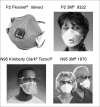Emergency department personal protective equipment requirements following out-of-hospital chemical biological or radiological events in Australasia
- PMID: 17448093
- PMCID: PMC7163549
- DOI: 10.1111/j.1742-6723.2007.00927.x
Emergency department personal protective equipment requirements following out-of-hospital chemical biological or radiological events in Australasia
Abstract
Recent events have led to a revision in ED equipment, preparedness and training for disasters. However, clinicians must still decide when, and what level of personal protection is required when a toxic threat exists. If possible, clear, simple and achievable protocols are required in such situations. Following an off-site Australasian chemical biological or radiological incident, current evidence indicates that the initial receiving ED staff will be adequately protected from all known chemical biological and radiological inhalational threats by wearing a properly fitted P2 (N95) mask, or its equivalent. Protection from serious contact injury is offered by wearing double gloves, disposable fluid-repellent coveralls or gown, eye protection, surgical mask, and ideally, a cap and shoe covers; in conjunction with universal precautions and procedures.
Similar articles
-
Chemical-biological-radiological (CBR) response: a template for hospital emergency departments.Med J Aust. 2002 Aug 19;177(4):196-9. doi: 10.5694/j.1326-5377.2002.tb04732.x. Med J Aust. 2002. PMID: 12175324
-
Chemical-biological-radiological (CBR) response: a template for hospital emergency departments.Med J Aust. 2003 Feb 3;178(3):141; author reply 141. doi: 10.5694/j.1326-5377.2003.tb05112.x. Med J Aust. 2003. PMID: 12776733 No abstract available.
-
Chemical-biological-radiological (CBR) response: a template for hospital emergency departments.Med J Aust. 2003 Feb 3;178(3):140-1; author reply 141. doi: 10.5694/j.1326-5377.2003.tb05111.x. Med J Aust. 2003. PMID: 12558489 No abstract available.
-
Chemical, biological and radiation casualties: critical care considerations.J R Army Med Corps. 2009 Jun;155(2):160-71. doi: 10.1136/jramc-155-02-17. J R Army Med Corps. 2009. PMID: 20095187 Review.
-
Nuclear/radiological terrorism: emergency department management of radiation casualties.J Emerg Med. 2007 Jan;32(1):71-85. doi: 10.1016/j.jemermed.2006.05.034. J Emerg Med. 2007. PMID: 17239736 Review.
Cited by
-
Maintaining Preparedness to Severe Though Infrequent Threats-Can It Be Done?Int J Environ Res Public Health. 2020 Mar 31;17(7):2385. doi: 10.3390/ijerph17072385. Int J Environ Res Public Health. 2020. PMID: 32244530 Free PMC article.
-
How would Australian hospital staff react to an avian influenza admission, or an influenza pandemic?Emerg Med Australas. 2009 Feb;21(1):12-24. doi: 10.1111/j.1742-6723.2008.01143.x. Emerg Med Australas. 2009. PMID: 19254308 Free PMC article.
-
Perception and performance of preventive behaviors for the pandemic influenza in hospital employees and outpatients.Yonsei Med J. 2011 Jan;52(1):181-7. doi: 10.3349/ymj.2011.52.1.181. Yonsei Med J. 2011. PMID: 21155052 Free PMC article.
References
-
- Australasian College for Emergency Medicine. Policy document: emergency department hazardous material response plan: staff participation. Emerg. Med. Australas. 2004; 16: 177. - PubMed
-
- Burgess JL, Kirk M, Borron SW, Cisek K. Emergency department hazardous materials protocol for contaminated patients. Ann. Emerg. Med. 1999; 34: 205–12. - PubMed
-
- Okumura T, Suzuki K, Fukuda A et al. The Tokyo subway sarin attack: disaster management, Part 2: hospital response. Acad. Emerg. Med. 1998; 5: 618–24. - PubMed
-
- Council on Scientific Affairs. Medical Preparedness for Terrorism and Other Disasters. Chicago: American Medical Association, June 2000. Available from URL: http://www.ama-assn.org/ama/pub/category/14313.html[Accessed 12 August 2006].
-
- Hick JL. Protective equipment for health care facility decontamination personnel: regulations, risks, and recommendations. Ann. Emerg. Med. 2003; 42: 370–80. - PubMed
Publication types
MeSH terms
LinkOut - more resources
Full Text Sources
Medical
Miscellaneous


